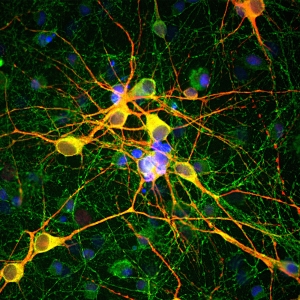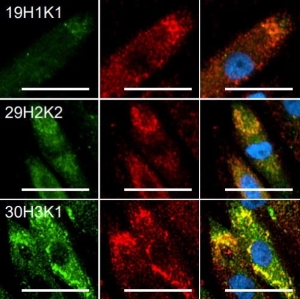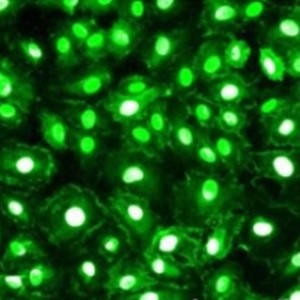Product Details
Product Sizes
| Size | List Price | Price | Cart |
|---|---|---|---|
| 100 ul | $325.00 | Add to Cart |
Calbindin, also known as calbindin 1 or calbindin-D28k is a member of the large superfamily of cytoplasmic Ca2+ binding proteins. Calbindin-1 belongs to the subclass of these containing the "EF hand" Ca2+ binding motif originally characterized in parvalbumin. Calbindin is expressed in mammalian brain, intestine, kidney, and pancreas. In the brain it is localized in certain classes of neurons, and antibodies to it are useful for identifying specific neuronal cell types. It is particularly concentrated in the dendrites and perikarya of cerebellar Purkinje cells, but is also found in many GABAergic interneurons in the cortex. The function of calbindin-1 appears to be primarily buffering the Ca2+ level in cells. The affinity of calbindin for Ca2+ is low at the typical resting cytoplasmic Ca2+ level of around 100 nM, and the protein only binds Ca2+ significantly when levels increase greatly. Accordingly, it is widely thought that the primary function of this protein is to act as a Ca2+ buffer. Buffering Ca2+ is important, as uncontrolled increases in the level of this cation can lead to both apoptosis due to Ca2+stimulated release of proteins from mitochondria and necrosis due to the activation of Ca2+dependent proteases. |
- Product Reviews- - Rating:
Leave a review for this product and you could be eligible for a $10 Starbucks gift card.
- Product Publications
Product Publications
- Cayla E. Jewett, Bailey L. McCurdy, Eileen T. O'Toole, Alexander J. Stemm-Wolf, Katherine S. Given, Carrie H. Lin, Valerie Olsen, Whitney Martin, Laura Reinholdt, Joaquín M. Espinosa, Kelly D. Sullivan, Wendy B. Macklin, Rytis Prekeris, and Chad G. Pearson. (2023). Trisomy 21 Induces Pericentrosomal Crowding Delaying Primary Ciliogenesis and Mouse Cerebellar Development. eLife, 11:e78202. doi: 10.7554/eLife.78202
- Jennifer Rios-Pilier and Robin F. Krimm. (2019). TrkB expression and dependence divides gustatory neurons into three subpopulations. Neural Development 2019 14:3 https://doi.org/10.1186/s13064-019-0127-z
If you've used this product in a publication, let us know. Email pshuster@neuromics.com, with the publication details and you could be eligible for an Amazon gift card.
- Related Products
Related Products
Name Catalog # Size Bradykinin Receptor B2 RA14137 100 ul CADM1/SynCAM RA25084 100 ul Calbindin MO20016 100 ug Calreticulin MO22164 100 ul Calretinin CH22116 100 ul Calretinin MO20024 100 ul Calretinin MO22166 100 ul Calretinin RA22144 100 ul Calretinin (IgG1) MO22165 100 ul CaMKII2A GT41019 100 ug EpCAM (Epithelial Cell Adhesion Molecule)/Epithelial Specific Antigen MO47063 100 ul MARCKS (Myristoylated Alanine Rich C Kinase Substrate) CH22137 100 ul MARCKS (Myristoylated Alanine Rich C Kinase Substrate) RA22111 100 ul Neurogranin precursor GT41024 100 ug phospho-Synapsin (Ser9) RA18009 100 ul S-100 MO47059 100 ul SHANK1a N-Terminus RA19015 100 ug Striatin RA25067 100 ul Synapsin RA18010 100 ul
Images
Ex-vivo cerebellar slices were fixed in 4% PFA for 20min. For IHC, sections were permeabilized in 10% Triton in PBS for 20min, rinsed in PBS and then blocked in 5% NDS in PBSTx (0.3%). Primaries we apply RT overnight in 5% NDS. We used Neuromics Ckn Calbindin (CH22118) at 1:1000 (green), combined with MBP (red) and Sox10 (blue). Courtesy of Katherine Given, University of Colorado
Ex-vivo cerebellar slices were fixed in 4% PFA for 20min. For IHC, sections were permeabilized in 10% Triton in PBS for 20min, rinsed in PBS and then blocked in 5% NDS in PBSTx (0.3%). Primaries we apply RT overnight in 5% NDS. We used Neuromics Ckn Calbindin (CH22118) at 1:1000 (green), combined with MBP (red) and Sox10 (blue). Courtesy of Katherine Given, University of Colorado
Adult rat brain cortex sections (45 μM; fixed by transcardial perfusion with 4% paraformaldehyde) were stained with our Calbindin (1:1,000, red), and our monoclonal mouse Fox3/NeuN (MO22112 ). Calbindin labels a subset of sparsely-distributed interneurons (calbindin-positvie interneurons) in the cortex. Since neurons also express Fox3/NeuN, calbindin-positive cells appear to be gold to yellow. Insets are high magnification images of boxed area of each image. Blue is Dapi nucleus staining.
Adult rat brain cortex sections (45 μM; fixed by transcardial perfusion with 4% paraformaldehyde) were stained with our Calbindin (1:1,000, red), and our monoclonal mouse Fox3/NeuN (MO22112 ). Calbindin labels a subset of sparsely-distributed interneurons (calbindin-positvie interneurons) in the cortex. Since neurons also express Fox3/NeuN, calbindin-positive cells appear to be gold to yellow. Insets are high magnification images of boxed area of each image. Blue is Dapi nucleus staining.
Adult rat brain striatum sections (45 μM; fixed by transcardial perfusion with 4% paraformaldehyde) were stained with our Calbindin (1:1,000, red), and our monoclonal mouse Fox3/NeuN (MO22112 ). Calbindin labels a subset of densely-distributed neurons in the striatum. Since neurons also express Fox3/NeuN, calbindin-positive cells appear to be gold to yellow. Inset is high magnification image. Blue is Dapi nucleus staining.
Adult rat brain striatum sections (45 μM; fixed by transcardial perfusion with 4% paraformaldehyde) were stained with our Calbindin (1:1,000, red), and our monoclonal mouse Fox3/NeuN (MO22112 ). Calbindin labels a subset of densely-distributed neurons in the striatum. Since neurons also express Fox3/NeuN, calbindin-positive cells appear to be gold to yellow. Inset is high magnification image. Blue is Dapi nucleus staining.
Western blot analysis of Calbindin. Blots of rat brain lysate (left), 0.5 µg of His-tagged recombinant proteins (right) were probed with Calbindin at 1:5,000. Lane1: Parvalbumin, Lane 2: Calretinin, Lane 3: Calbindin. In rat brain lysates, this antibody recognizes a clear band at 30 kDa which represents calbindin and it reacts only with calbindin protein, and not other calcium-binding proteins. The band at ~60 kDa is most likely the dimer of calbindin
Western blot analysis of Calbindin. Blots of rat brain lysate (left), 0.5 µg of His-tagged recombinant proteins (right) were probed with Calbindin at 1:5,000. Lane1: Parvalbumin, Lane 2: Calretinin, Lane 3: Calbindin. In rat brain lysates, this antibody recognizes a clear band at 30 kDa which represents calbindin and it reacts only with calbindin protein, and not other calcium-binding proteins. The band at ~60 kDa is most likely the dimer of calbindin






